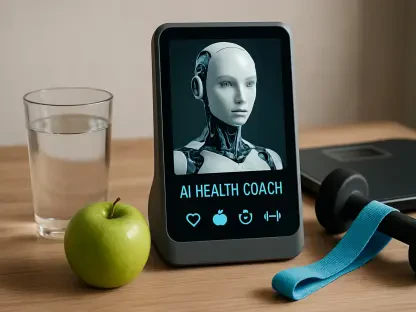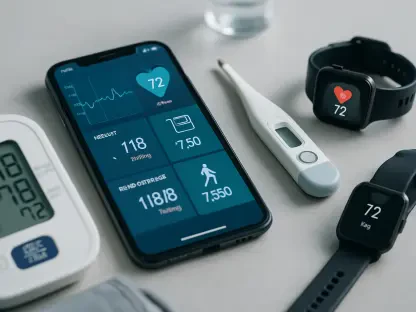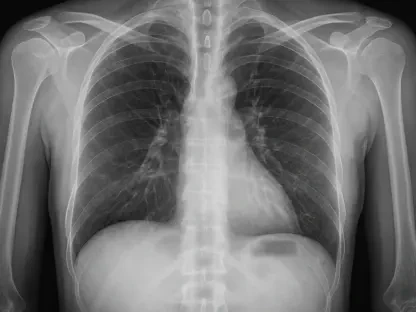In an era where technology increasingly intertwines with daily life, OpenAI, the innovative force behind ChatGPT, is embarking on a groundbreaking journey into the healthcare sector by targeting the elusive goal of unified personal health records (PHRs). This ambitious project seeks to create a centralized digital platform that consolidates an individual’s medical history, lab results, and other critical health data into a single, user-friendly interface. With an impressive user base of over 800 million already relying on ChatGPT for health-related inquiries, OpenAI is poised to leverage its expertise in conversational AI to address a challenge that has repeatedly defeated tech giants like Google and Microsoft. The vision extends beyond mere data storage, aiming to deliver a personalized health assistant powered by generative AI for real-time insights and recommendations. However, this bold step into healthcare is not without significant obstacles, including privacy concerns, regulatory complexities, and historical failures in the field. The path forward promises both innovation and uncertainty as OpenAI navigates this intricate landscape.
Revisiting Past Failures in Personal Health Records
The quest for a successful PHR system has been a stumbling block for even the biggest names in technology, underscoring the daunting nature of OpenAI’s endeavor. Google Health, launched in 2008, was shut down just four years later amid privacy controversies and tepid user engagement. Similarly, Microsoft’s HealthVault, introduced in 2007, faded by 2019 due to insufficient adoption, while Amazon’s forays, including the Halo fitness tracker, collapsed under data security concerns by 2023. These high-profile setbacks reveal the intricate balance between technological advancement and stringent regulations like the Health Insurance Portability and Accountability Act (HIPAA) in the U.S. Beyond legal hurdles, gaining user trust and ensuring practical utility have proven elusive. OpenAI must dissect these past failures to understand the pitfalls of low engagement and public skepticism, crafting a strategy that prioritizes both functionality and reassurance in a field littered with cautionary tales.
Moreover, the historical context shows that the healthcare data space demands more than just innovation—it requires a delicate balance of accessibility and protection. Previous attempts often faltered because they couldn’t bridge the gap between complex medical systems and everyday users, leaving platforms underutilized. Privacy scandals further eroded confidence, as consumers feared their sensitive information could be mishandled. For OpenAI, learning from these missteps means not only building a robust technical solution but also fostering an environment where users feel secure and empowered. Addressing the reasons behind past low adoption rates, such as unintuitive interfaces or lack of clear benefits, will be crucial. The challenge lies in transforming a concept that has repeatedly failed into a tool that seamlessly integrates into people’s lives while adhering to strict ethical and legal standards that govern health information.
Leveraging AI and User Base for a New Approach
OpenAI brings a distinctive advantage to the PHR challenge through its mastery of conversational AI and an already established rapport with millions of users. Unlike earlier initiatives that focused solely on data aggregation, this venture aims to harness generative AI to provide real-time analysis and personalized health guidance, such as timely medication reminders or wellness tips. Strategic appointments, including healthcare strategy expert Nate Gross, signal a commitment to blending medical expertise with user-centric design. With an interface designed for natural, engaging interactions, OpenAI could overcome the adoption barriers that plagued predecessors. The trust embedded in a platform like ChatGPT, used by over 800 million individuals, offers a unique starting point to introduce a health tool that feels familiar and accessible to a vast audience.
Additionally, the scale of OpenAI’s user engagement provides a foundation that past PHR systems lacked, potentially redefining how health data is perceived and utilized. The conversational nature of AI-driven interactions can simplify complex medical information, making it more digestible for the average person. This approach contrasts sharply with the often sterile and technical interfaces of earlier platforms, which failed to resonate with users. By prioritizing intuitive design, OpenAI has the chance to turn a utilitarian concept into a daily companion for health management. However, capitalizing on this advantage will require continuous refinement to ensure accuracy in AI recommendations and relevance to individual needs. Building on this existing user trust, the company must also demonstrate an unwavering commitment to safeguarding personal data to maintain credibility in a sensitive domain like healthcare.
Navigating the Minefield of Privacy and Regulation
One of the most formidable barriers facing OpenAI’s foray into PHRs is the pervasive concern over privacy, amplified by public discourse on platforms like X. Many fear that sensitive medical data could be exploited by insurers or other entities, potentially weakening protections enshrined in HIPAA. Currently, ChatGPT limits itself to general health information to minimize liability, but expanding into personalized health tools will intensify these concerns. The specter of data breaches or misuse looms large, with users wary of how their most intimate information might be handled. OpenAI must navigate a complex web of federal laws and public expectations to ensure that security measures are not just robust but also transparent, reassuring users that their privacy remains paramount in this digital health evolution.
Beyond public apprehension, regulatory compliance presents a labyrinth of challenges that could make or break this initiative. Adhering to strict guidelines like HIPAA is non-negotiable, requiring meticulous attention to how data is stored, shared, and accessed. The risk of inadvertently violating these rules could result in legal repercussions and irreparable damage to reputation. OpenAI will need to invest heavily in systems that prioritize encryption and consent protocols while also preparing for evolving legislation around health data. Public skepticism, fueled by past tech industry missteps in handling personal information, adds another layer of difficulty. Establishing clear communication about data usage policies and involving regulatory bodies in the development process could help mitigate these risks. Success in this arena hinges on balancing cutting-edge technology with an unwavering commitment to ethical standards that protect user rights.
Solving the Puzzle of Interoperability in Health Data
Interoperability—the seamless exchange of data across disparate systems like electronic health records (EHRs), wearables, and insurance databases—remains a critical hurdle for any PHR platform, including OpenAI’s. The ability of AI to parse and organize complex, fragmented data from multiple sources positions it as a potential game-changer in this space. If executed effectively, this capability could bridge gaps that have historically stymied integration efforts, creating a cohesive health profile for each user. Industry observers suggest that OpenAI’s vast scale might encourage reluctant healthcare stakeholders to collaborate on data sharing, provided there are guarantees of transparency and security. Solving this puzzle could redefine how health information flows, making it more actionable for both patients and providers.
Furthermore, achieving interoperability is not just a technical challenge but also a matter of trust and coordination among diverse entities in the healthcare ecosystem. Past PHR systems often failed because they couldn’t reconcile the varied formats and protocols used by different medical and insurance systems, leaving users with incomplete or inaccessible data. OpenAI’s AI-driven approach must focus on creating standardized pathways for data exchange while ensuring that no information is lost or misinterpreted in the process. Engaging with hospitals, clinics, and tech providers to build a unified framework will be essential. Additionally, addressing user concerns about who controls their data during these exchanges will play a significant role in gaining widespread acceptance. The potential to streamline this fragmented landscape offers a transformative opportunity, but it demands precision and partnership at every step.
AI’s Expanding Footprint in the Healthcare Sector
OpenAI’s push into PHRs aligns with a broader trend of AI’s growing influence in healthcare, with investments in related technologies projected to reach $1.4 billion this year. From automating medical scribing to enhancing payer operations, AI is reshaping inefficiencies in the industry. Unlike entrenched EHR players like Epic Systems, OpenAI’s strategy emphasizes a user-first, AI-native perspective that could disrupt traditional models. Investors are showing keen interest, viewing this as a chance to address persistent bottlenecks in health data management through innovative tools. This shift reflects a larger movement toward leveraging technology to improve patient outcomes and reduce administrative burdens, positioning OpenAI at the forefront of a dynamic transformation in medical services.
Equally important is the recognition that AI’s role extends beyond technical solutions to fundamentally altering how healthcare is delivered and experienced. By integrating real-time data analysis into PHRs, OpenAI could enable more proactive health management, empowering users with insights that were previously inaccessible without professional intervention. This contrasts with the static nature of many existing systems, which often serve as mere repositories rather than active tools. The enthusiasm from financial backers highlights confidence in AI’s potential to cut costs and enhance care quality, but it also underscores the need for rigorous validation to prevent errors. As AI continues to permeate healthcare, OpenAI’s initiative could serve as a catalyst for broader adoption of intelligent systems, provided it can demonstrate tangible benefits and reliability in handling sensitive health information.
Ethical Imperatives in a Data-Driven Health Future
The ethical dimensions of OpenAI’s venture into PHRs cannot be overstated, especially given the tech industry’s checkered history with personal data in healthcare. Public distrust, amplified by warnings of a potential “data broker economy” where sensitive information is commodified, poses a significant challenge. Voices on social platforms and in media stress the importance of safeguarding against exploitation, with some advocating for a digital bill of rights to protect health data. OpenAI must prioritize transparency in how information is used and shared, ensuring users feel in control. Collaborating with regulators and ethicists to establish clear guidelines will be vital to counter skepticism and build a foundation of trust in this sensitive arena.
Additionally, the responsibility to balance innovation with moral obligations requires a proactive stance on addressing potential risks before they manifest. Historical precedents of data mishandling by tech giants have left a lasting imprint on public perception, making it imperative for OpenAI to differentiate itself through ethical rigor. This includes implementing safeguards against AI biases or errors that could lead to harmful health advice, as well as ensuring equitable access to the platform. Engaging in open dialogue with users about privacy policies and involving independent auditors to verify security measures could help alleviate concerns. The path to integrating AI into personal health management must be paved with accountability, ensuring that technological advancements do not come at the expense of individual rights or societal trust in healthcare systems.









